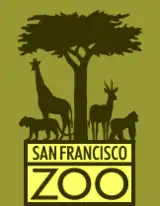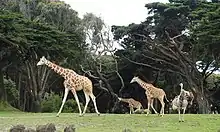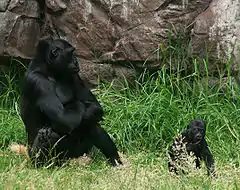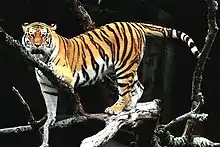San Francisco Zoo
The San Francisco Zoo is a 100-acre (40 ha) zoo located in the southwestern corner of San Francisco, California, between Lake Merced and the Pacific Ocean along the Great Highway. As of 2016, the zoo housed more than one thousand individual animals, representing more than 250 species. It is noted as the birthplace of Koko the gorilla, and, since 1974, the home of Elly, the oldest black rhinoceros in North America.[3]
 | |
 African Savannah | |
| Coordinates | 37°43′59″N 122°30′11″W |
|---|---|
| No. of animals | 1000+ (2015)[1] |
| No. of species | 250+ (2015)[1] |
| Memberships | AZA[2] |
| Major exhibits | African Savanna, Gorilla Preserve, Grizzly Gulch, Primate Discovery Center (Lemur Forest), Cat Kingdom, Penguin Island, Red Panda Treehouse, Insect Zoo |
| Public transit access | |
| Website | www |
The zoo's main entrance (once located on the north side across Sloat Boulevard and one block south of the Muni Metro L Taraval line) is to the west, on the ocean side.
History
Originally named the Fleishhacker Zoo[4] after its founder, banker and San Francisco Parks Commission president Herbert Fleishhacker, planning for construction began in 1929 on the site adjacent to what was once the largest swimming pool in the United States, the Fleishhacker Pool.[1] The area was also already home to a children’s playground, an original (circa 1921) Michael Dentzel/Marcus Illions carousel, and the Mother’s Building, a haven for women and their children. Most of the exhibits were populated with animals transferred from Golden Gate Park, including two zebras, a cape buffalo, five rhesus monkeys, two spider monkeys, and three elephants (Virginia, Marjorie, and Babe).
The first exhibits built in the 1930s cost $3.5 million, which included Monkey Island, Lion House, Elephant House, a small mammal grotto, an aviary, and bear grottos. These spacious, moated enclosures were among the first bar-less exhibits in the country. In 1955, a local San Francisco newspaper purchased Pennie, a baby female Asian elephant, and donated her to the zoo after many children donated their pennies, nickels, and dimes for her purchase.
Over the next forty years, the Zoological Society became a powerful fundraising source for the San Francisco Zoo, just as Fleishhacker had hoped when he envisioned: "…a Zoological Society similar to those established in other large cities. The Zoological Society will aid the Parks Commission in the acquisition of rare animals and in the operation of the zoo." True to its charter, the Society immediately exerted its influence on the zoo, obtaining more than 1,300 annual memberships in its first ten years (nearly 25,000 today). It also funded projects like the renovation of the Children’s Zoo in 1964, development of the African Scene in 1967, the purchase of medical equipment for the new zoo Hospital in 1975, and the establishment of the Avian Conservation Center in 1978.
In November 2004, Tinkerbelle, San Francisco Zoo's last Asian elephant, was moved to ARK 2000, a sanctuary run by PAWS-Performing Animal Welfare Society located in the Sierra Nevada foothills. She was later joined in March 2005 by the African elephant Lulu, the last elephant on display at the zoo. The moves followed the highly publicized deaths of thirty-eight-year-old Calle in March 2004, and forty-three-year-old Maybelle the following month.[5]
In early 2006, the SF Zoo announced its offer to name a soon-to-hatch American bald eagle after comedian Stephen Colbert.[6] The publicity and goodwill garnered from coverage of the event on the Colbert Report was a windfall for the zoo and the city of San Francisco. Stephen Jr. was born on April 17, 2006.
Exhibit renovations
|
|
Animals and exhibits
Peafowl roam the zoo grounds freely and are acknowledged officially on the zoo's website.
African Savannah
African Aviary

Primate Discovery Center
Cat Kingdom
Outback Trail
South America
- Black-necked swan
- Black swan
- Capybara
- Giant anteater
- Maguari stork
- White-faced whistling duck
- South American tropical tortoise
- Blue poison dart frog
- Golfodulcean poison frog
- Green anaconda
- Waxy monkey tree frog
Bear Country
Pelican Beach
Children's Zoo
Safety incidents and animal deaths
March, 2015: Treatment of chimps endangers SF Zoo's accreditation: http://www.sfchronicle.com/bayarea/article/S-F-Zoo-s-remaining-chimps-endanger-6120334.php
November, 2014: Baby Kabibe, Western Lowland Gorilla crushed to death by automatic door, SF Zoo ignored safety: (https://web.archive.org/web/20141201183902/http://ww2.kqed.org/news/2014/11/12/investigator-of-baby-gorilla-death-says-time-to-dramatically-upgrade-sf-zoo)
2004: Elephant deaths and antiquated habitat (http://articles.latimes.com/2004/dec/12/local/me-elephants12)
2007 tiger attacks

On December 22, 2006, Tatiana, the 242-pound Siberian tiger, attacked zookeeper Lori Komejan, causing the keeper to be hospitalized for several weeks with lacerated limbs and shock. The Lion House was closed for ten months as a result. California's Division of Occupation Safety and Health found the zoo liable for the keeper's injuries, fined the zoo, and ordered safety improvements.[7][8][9]
On December 25, 2007, the same tiger escaped from her grotto and attacked three zoo visitors after being taunted and pummeled by sticks and pine cones by the visitors. Carlos Sousa, 17, of San Jose, California, was killed at the scene, while another taunter was mauled and survived. The tiger was shot and killed by police while hiding in the landscape after the attack. Three other tigers who shared Tatiana's grotto did not escape.[10][11] Tatiana arrived at the San Francisco Zoo from the Denver Zoo in 2005, in hopes that she would mate.[12] (This "Tatiana" is not the same as the one successfully breeding in the Toronto Zoo.) According to the Association of Zoos and Aquariums, the attack is the first visitor fatality due to animal escape at a member zoo in the history of the organization.[13]
Conservation
Two black bears were rescued as orphans in Alaska. The male was found on the edges of town near Valdez in May 2017 and the female cub was found near Juneau in June 2017. Both cubs were determined by the Alaska Department of Fish and Game to be motherless and were brought to Alaska Zoo and rehabilitated back to health. In 2017, the Alaska Zoo had more orphaned bear cubs than ever before, due to the repeal of bear hunting regulations by the Trump administration, which allowed for the hunting of hibernating bears in their dens. Mr. Lampi said. [14][15][16] The two bears were brought to the San Francisco Zoo in 2017 and a previously empty habitat was repurposed to host them.[17]
The zoo houses Henry, a 10-year-old blind Californian seal lion 7 which was found stranded on a beach in Humboldt County in 2010. In 2012, he was brought to the San Francisco Zoo, he was treated by veterinarians for his blindness. [18]
Species survival projects
The San Francisco Zoo participates in Species Survival Plans, conservation programs sponsored by the Association of Zoos and Aquariums. The program began in 1981 for selected species in North American zoos and aquariums where the breeding of a species done to maintain healthy, self-sustaining, genetically diverse and demographically stable populations.[19] The zoo participates in more than 30 SSP programs, working to conserve species ranging from Madagascan radiated tortoises and reticulated giraffes to black rhinos and gorillas.
References
- Press Room (2011). "Zoo Fact Sheet". San Francisco Zoological Society. Archived from the original on September 28, 2011. Retrieved 2012-11-17.
- "Currently Accredited Zoos and Aquariums". aza.org. AZA. Retrieved 10 August 2011.
- "Oldest black rhinoceros in North America turns 45", by Janie Har, Associated Press
- Darold Fredricks (December 23, 2013). "Fleishhacker Zoo". San Mateo Daily Journal. Archived from the original on September 16, 2014.
- Patricia Yollin (2005-03-04). "Zoo to Send 2 Elephants to Sanctuaries; Director defies Recommendation to Ship Pachyderms to Other Zoos". The San Francisco Chronicle. Retrieved 2006-12-27.
- Leah Garchik (2006-03-31). "Leah Garchik". The San Francisco Chronicle. Retrieved 2006-12-27.
- Carolyn Marshall (2007-12-26). "Tiger kills 1 after escaping at San Francisco Zoo". The International Herald Tribune. Retrieved 2007-12-26.
- Michael Taylor; Patricia Yollin (2006-12-23). "Zoo keeper hurt in tiger attack". The San Francisco Chronicle. Retrieved 2007-12-26.CS1 maint: multiple names: authors list (link)
- Patricia Yollin (2007-09-07). "Zoo reopens Lion House for public feedings 10 months after mauling". San Francisco Chronicle. Retrieved 2007-12-25.
- Ron Ruegg (2007-12-25). "Escaped tiger shot after killing zoo visitor, injuring 2 others". CNN. Retrieved 2007-12-25.
- Glenn Chapman (2007-12-26). "Escaped tiger kills one, injures two at San Francisco zoo". Agence France Presse. Retrieved 2007-12-26.
- Jordan Robertson; Marcus Wohlsen (2007-12-28). "Teen Died Trying to Save Man From Tiger". Associated Press. Retrieved 2008-07-23.CS1 maint: multiple names: authors list (link)
- Staff writers (2007-12-26). "California teen named as victim of tiger mauling". CNN. Retrieved 2007-12-26.
- "Rescued black bears find new home". www.sfzoo.org. Retrieved 25 July 2020.
- "Cubs at SF Zoo highlight glut of orphaned Alaskan bears". SFChronicle.com. 12 August 2017. Retrieved 25 July 2020.
- "Orphaned bear cubs find temporary homes at the Alaska Zoo". Anchorage Daily News. 26 July 2017. Retrieved 26 July 2020.
- "Cubs at SF Zoo highlight glut of orphaned Alaskan bears". SFChronicle.com. 12 August 2017. Retrieved 26 July 2020.
- "SF Zoo's blind sea lions look on the bright side". SFChronicle.com. 27 May 2017. Retrieved 25 July 2020.
- "Species Survival Plan Program". Association of Zoos and Aquariums. 29 April 2008. Archived from the original on 2008-02-29. Retrieved 2008-07-23.
External links
| Wikinews has news related to: |
![]() Media related to San Francisco Zoo at Wikimedia Commons
Media related to San Francisco Zoo at Wikimedia Commons
run web gi tunnel = vps